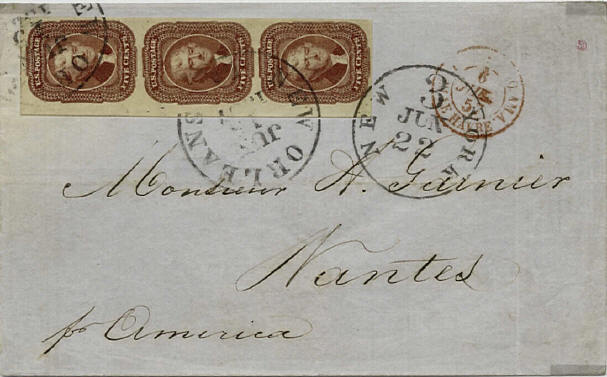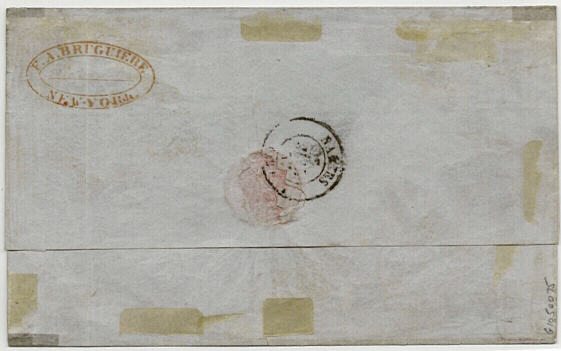|
The Consul Klep Cover |
|
|
|
|
Introduction - This is the text of my letter to clients, with minor corrections, regarding the famous Consul Klep cover that was withdrawn from the Siegel sale of the Zoellner collection and which later received a bad Philatelic Foundation certificate. It was written prior to the Zoellner sale and is shown here as an example of the expertising process that I used. The illustrious history of the cover was discussed in an article in Linn's.

Front of the "Consul Klep" Cover

Reverse of the "Consul Klep" Cover
To Whom It May Concern:
I have been asked on behalf of clients to examine the "Consul Klep" cover because of their interest in bidding on the cover in the Siegel auction. I examined the cover on September 29, 1998 after having determined that there were several unusual aspects of the cover that needed to be studied more closely.
Some of the potential problems that were identified before examining the cover are listed below:
1.
The black "New York 3 June 22" debit postmark does not correspond with a
prepaid 15c treaty rate to France. It should be in red.
2. The Havre entry marking is reported only in conjunction with pre treaty
carriage by Ocean Line vessels with the latest reported usage of December, 1856.
After the treaty with France new devices were introduced. Dick Winter, as
confirmed by another source, report that the new markings are known in April and
May, 1857.
3. The cover does not bear a "P.D." as usually found on prepaid treaty mail.
4. The covers bears an oval New York forwarders backstamp (F.A. Brugiere, New
York) which, both specifically and as a category of marking, are almost
invariably associated with mail carried privately. It is highly unusual that
this fact, termed "condemnatory" by Michael Laurence, was not
mentioned when this cover was described by Scott Trepel when he sold the cover
in the Grunin sale at Christies (where it was purchased by Zoellner) and again
not described in the catalog of the Zoellner sale.
5. The handwriting of the address matches Garnier correspondence covers
originating in New York City and Charleston, S.C. rather than New Orleans.
6. It seems unlikely that a sender in New Orleans on June 15, 1857 would think
that the cover could make it to Boston to catch the steamer America, as
endorsed, which was scheduled to leave Boston on June 17, 1857.
7. There appears to be a problem with the dates in regard to service from New
York to Havre. The only sailing that fits is by the Cunarder Canada which is
listed in the Winter book as departing New York City on June 24, 1857 and
arriving Liverpool on July 7, 1857. However, as evidenced by the attached copy,
it appears from physical evidence that the Canada arrived on July 6, 1857. As
another cover I found record of bears a Bristol backstamp of the next day, it
seems likely that there is an error in Winter's listing. This sailing would,
then, fit the Klep cover dates.
Upon examination my findings are as follows:
1.
The strip itself has been repaired. There is a repaired tear to left of the
center stamp even with the value tablet. The top stamp has a repaired pin hole
in the upper lip. Both these repairs are best seen with strong backlighting but
the marginal repair also shows under black light (I used a spectroline model
B-100, circa 1940.) To me, this is indicative that the strip has at least been
off the cover and further, because of the pin hole, that there is a possibility
that the strip was a "pin up." Stamps were frequently pinned to boards by
early French dealers.
2. The red ink of the Havre entry mark has been painted, possibly on top of a
faked handstamp. The "feathering" at the bottom is the best place to view
this evidence. Instead of being a float type smear as would occur on a real
device being struck with more pressure at the bottom, it shows as individual
lines of color radiating and extending beyond the circle.
3. The New York debit marking appears to be fake. There is evidence of very
clever painting but with uneven application of color, possibly over a fake
handstamp. Under UV light this marking does not match comparison copies from the
approximate period.
4. The "New Orleans" postmarks on both cover and strip show evidence of
being painted in, again possibly over a faked handstamp, or parts of the
original faint New Orleans postmark on the strip. The "O" of "Orleans"
on the cover shows the clearest evidence of paint rather than ink. Under UV
light this does not match comparison copies of New Orleans postmarks circa
1857/1858.
5. The "Nantes" receiver is the most deceptive for me. I have no comparison
examples but the ink seems very "flat." The marking appears on top of a
shred piece of backflap and is again repeated underneath on the red wax seal. I
suppose that it is possible to bleed through from ink, but is equally probable
that it could have been painted in. I am informed, after consultation, that the
mark is not correct in the spacing for the period. My tests were inconclusive.
6. The New York forwarder backstamp appears to be genuine.
7. The cover does not have any offsets on verso (even small ink smears) which
would be expected on a cover that passed through three "batch" handlings (at
New Orleans, at New York, and again at Havre.) Usually covers would bear at
least some smudge offset from being placed on top off freshly postmarked
letters, especially with the strength of the ink appearing on this cover.
8. The cover does not appear to have been cleaned, only pressed.
9. The interior sides flaps have been trimmed in such a fashion as to indicate
at least a suspicion that a docket was removed.
After the above examination, it is my opinion that the cover has been faked.
1. I
believe that the cover was carried entirely out of the mails from some point in
the United States, most likely Charleston, via a New York forwarder, to Nantes
at some unknown date. The fact that it has a New York forwarder on the verso is
very hard, if not impossible, to reconcile with a genuine usage. For it to be
real, it would have had to have been carried in the government mails from New
Orleans, delivered to the forwarder and placed back into the government mails by
the forwarder. One possibility, proposed by Scott Trepel, is that the forwarder
handstamp was applied by the Brougiere agent in New Orleans as a sender cachet
while visiting on business. Because the marking is struck on the reverse,
similar to known forwarding usages from this firm, I consider this to be a
stretch.
2. All pertinent markings, other than the NY forwarder are fake.
3. The strip, which is genuine, undoubtedly had genuine New Orleans postmarks
that probably were from June or July, 1857 based on the shade. The strip has
been repaired and added to the cover with fake ties and postmark enhanced and
altered on the strip.
If, as I believe, the cover is fake, I do not know who made it. It seems much better than I have seen associated with Zaretsky ( a prolific forger who made up a number of fake 30c 1869 covers), although it does fit his modus operandi of adding defective stamps to a stampless cover.
It is possibly linked to the workshop of J. E., a Parisian repair man and faker working in the late 1940's and early 1950's. I knew nothing about this faker until very recently. I have heard that he had a group of men working for him in a shop. All were doing repair work and faking of covers under UV light and specifically that they did US covers. Most of their work was "custom" work whereby a dealer would request a specific result and supply the materials. Apparently his name is not well known because several of the dealers that he did such work for are either still alive, or the business is still operating. The quality of the work has been termed "superb" by the three people who would talk to me about it. One of his specialties was painting postmarks by reflecting images of actual postmarks onto the "patient" and painting over the image.
Not that it matters much, but I'm not so sure that Ashbrook ever saw this cover in the flesh when he gave his written opinion. He usually signed covers that he examined directly and the photo in Special Service appears to be second generation. I doubt if he had an opportunity to view the verso.
Lastly, as a curious thing, there is a thumbprint shows under UV light at left which "ties" the strip. This would be the left thumbprint of the faker. Signed, Richard Frajola
Richard Frajola (October 12, 1998)


